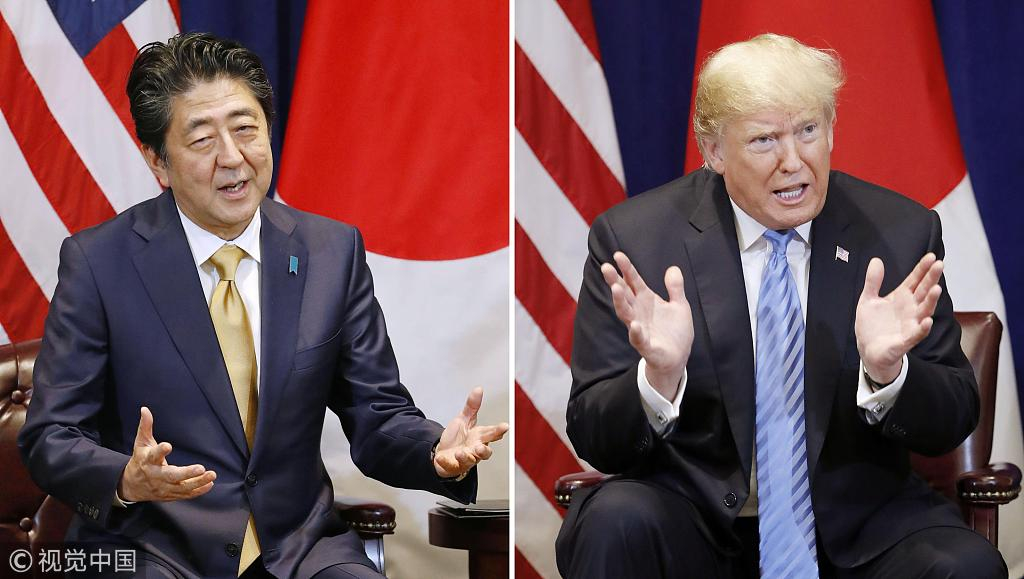
Opinion
08:56, 20-Jan-2019
Opinion: U.S.-Japan trade talk: Is a deal coming soon?
Updated
20:26, 20-Jan-2019
Liu Chunsheng

Editor's note: Liu Chunsheng is an associate professor of Central University of Finance and Economics in China as well as deputy dean of Blue Source Capital Research Institute. The article reflects the author's opinion, and not necessarily the views of CGTN.
On January 19, the U.S. federal government has shut down for almost a month, but the U.S. Trade Representative Office (USTR) is continuing its operations, including trade negotiations and enforcement. In addition to the in-depth trade talks with China, the U.S.-Japan trade dialogue is expected to start on January 20.
The United States is seeking to substantially reduce the trade deficit of 69 billion U.S. dollars between the United States and Japan, the world's third-largest economy. It inevitably brought us back to the U.S.-Japan trade war decades ago.
In 1965, Japan experienced a trade surplus with the United States and then became the second largest economy in the world, thereby increasing the trade friction between the two countries. Since the 1970s, Japan's economic strength had been further consolidated, while its trade dispute with the U.S. continued to escalate. The frictions gradually expanded from textiles to steel, home appliances, ships, automobiles, and semiconductors.

Japanese cars on assembly line at Toyota Motors plant, 1952. /VCG Photo
Japanese cars on assembly line at Toyota Motors plant, 1952. /VCG Photo
In the end, Japan made compromises including “voluntary export restrictions,” opening its domestic market and controlling export prices. In 1985, Japan signed the Plaza Accord and the yen was forced to appreciate significantly, 90.4 percent by 1988, resulting in soaring asset prices and burst real estate bubbles. Since then, the Japanese economy has stagnated for decades.
In 1989, the United States initiated an industry-wide "trade war" against Japan by launching the Super 301, requiring Japan to open up some domestic markets, forcing it to revise domestic economic policies and guidelines, as well as abolish laws that prevent foreign companies from entering the Japanese market.
History is the best teacher, not to mention that Robert Lighthizer, who dominated the U.S.-Japan trade negotiations, is still in his place. The trade structure and status between Japan and the United States have not seen fundamental changes as well for the past decades.
Steel, home appliances, automobiles, and semiconductors are still the main commodities exported by Japan to the United States, serving as the biggest contributor to Japan's trade surplus. Meanwhile, Japan's excessive dependence on the U.S. in its markets and military remain the same. During this round of trade talks, Japan's chips are no more than a few decades ago.
According to documents released by the White House last December, the United States will seek duty-free market access for its industrial products and reduce or eliminate Japan's tariffs on U.S. agricultural products. The United States will also strive for greater access to Japan's auto markets and ensure that Japan will not manipulate the exchange rate. Does it ring a bell?
Japan is not awaiting its doom. The U.S.' tough attitude seems to have spurred a diplomatic change in Japan, who has begun to focus on easing relations with Asian countries, and reached a trade deal with the EU before the U.S. does. The Economic Cooperation Agreement (EPA) signed between Japan and the EU will come into effect on February 1. Both sides will cancel the import tax on the other's goods, which means that Japan will open its doors to U.S. counterparts from the EU in various fields.

U.S. Trade Representative Robert Lighthizer (R) and Japanese Minister of Economy, Trade and Industry, Hiroshige Seko (L) at the offices of the EU Delegation in Washington, D.C., U.S., January 9. /VCG Photo
U.S. Trade Representative Robert Lighthizer (R) and Japanese Minister of Economy, Trade and Industry, Hiroshige Seko (L) at the offices of the EU Delegation in Washington, D.C., U.S., January 9. /VCG Photo
However, Japan still does not have the leverage against the U.S. in trade negotiations. It is difficult for Japan to reject the demands of the United States, and even harder to restrict the United States by partnering with other countries.
On the other hand, the process of Japan-U.S. trade negotiations may become a reference point for U.S.-China trade talks. In particular, whether the Japan-U.S. final agreement will also be inserted into the poison pill clause against China is worthy of attention.
(If you want to contribute and have specific expertise, please contact us at opinions@cgtn.com.)

SITEMAP
Copyright © 2018 CGTN. Beijing ICP prepared NO.16065310-3
Copyright © 2018 CGTN. Beijing ICP prepared NO.16065310-3